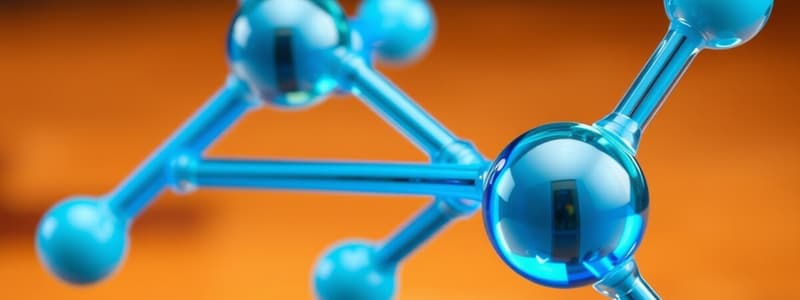Podcast
Questions and Answers
How many valence electrons are found in an atom of calcium?
How many valence electrons are found in an atom of calcium?
2 valence electrons
Atoms of which element have 4 valence electrons?
Atoms of which element have 4 valence electrons?
Carbon
Which Lewis Dot Structure is accurate for the element nitrogen?
Which Lewis Dot Structure is accurate for the element nitrogen?
Diagram D
Which Lewis Dot Structure is accurate for the element calcium?
Which Lewis Dot Structure is accurate for the element calcium?
Signup and view all the answers
Which group of elements satisfies the octet rule without forming bonds?
Which group of elements satisfies the octet rule without forming bonds?
Signup and view all the answers
Atoms of which element will have 8 valence electrons?
Atoms of which element will have 8 valence electrons?
Signup and view all the answers
Which atoms are most likely to form covalent bonds?
Which atoms are most likely to form covalent bonds?
Signup and view all the answers
Which compound contains an ionic bond?
Which compound contains an ionic bond?
Signup and view all the answers
Which Lewis Dot Structure is accurate for the element carbon?
Which Lewis Dot Structure is accurate for the element carbon?
Signup and view all the answers
Which bonding description between magnesium and oxygen is correct?
Which bonding description between magnesium and oxygen is correct?
Signup and view all the answers
Which compound contains a covalent bond?
Which compound contains a covalent bond?
Signup and view all the answers
Which element will form an ionic bond with fluorine (F)?
Which element will form an ionic bond with fluorine (F)?
Signup and view all the answers
Which Lewis Dot Structure is accurate for the element sulfur?
Which Lewis Dot Structure is accurate for the element sulfur?
Signup and view all the answers
Which bonding description between hydrogen and chlorine is correct?
Which bonding description between hydrogen and chlorine is correct?
Signup and view all the answers
Which Lewis Dot Structures are not accurate for the element beryllium?
Which Lewis Dot Structures are not accurate for the element beryllium?
Signup and view all the answers
In the compound aluminum phosphide, what is the charge of the aluminum ion?
In the compound aluminum phosphide, what is the charge of the aluminum ion?
Signup and view all the answers
Which diagram correctly displays the Lewis Dot Structure and charges for beryllium oxide?
Which diagram correctly displays the Lewis Dot Structure and charges for beryllium oxide?
Signup and view all the answers
In the compound zinc chloride, what is the charge of the zinc ion?
In the compound zinc chloride, what is the charge of the zinc ion?
Signup and view all the answers
Aluminum (Al) will form an ion with a -2 charge.
Aluminum (Al) will form an ion with a -2 charge.
Signup and view all the answers
Which diagram correctly displays the Lewis Dot Structure and charges for lithium fluoride?
Which diagram correctly displays the Lewis Dot Structure and charges for lithium fluoride?
Signup and view all the answers
Potassium will transfer two electrons to bromine in potassium bromide (KBr).
Potassium will transfer two electrons to bromine in potassium bromide (KBr).
Signup and view all the answers
Which diagram correctly displays the Lewis Dot Structure and charges for barium chloride?
Which diagram correctly displays the Lewis Dot Structure and charges for barium chloride?
Signup and view all the answers
Which element will NOT form a positively charged ion?
Which element will NOT form a positively charged ion?
Signup and view all the answers
Which statement best describes the compound magnesium sulfide (MgS)?
Which statement best describes the compound magnesium sulfide (MgS)?
Signup and view all the answers
Which compounds contain an ion with a +2 charge and an ion with a -1 charge?
Which compounds contain an ion with a +2 charge and an ion with a -1 charge?
Signup and view all the answers
Study Notes
Valence Electrons and Elements
- Calcium has 2 valence electrons.
- Carbon has 4 valence electrons.
- Neon possesses 8 valence electrons.
- Noble gases satisfy the octet rule without forming bonds.
Lewis Dot Structures
- Diagram D accurately represents nitrogen's Lewis Dot Structure.
- Diagram C accurately reflects calcium’s Lewis Dot Structure.
- Diagram B is the correct Lewis Dot Structure for carbon.
- Diagram C accurately depicts the Lewis Dot Structure for sulfur.
- Diagram A properly displays lithium fluoride's Lewis Dot Structure.
- Diagram D correctly illustrates barium chloride's Lewis Dot Structure.
Types of Bonds
- Covalent bonds are primarily formed between non-metal atoms sharing electrons.
- Ionic bonds are indicated in compounds like calcium fluoride (CaF2) and magnesium sulfide (MgS).
- Hydrogen and chlorine form a covalent bond through the sharing of electrons.
Ionic and Covalent Compounds
- HBr is an example of a compound with a covalent bond.
- Beryllium will form an ionic bond when connected with fluorine (F).
- Aluminum phosphide contains aluminum ions with a 3+ charge.
- Zinc chloride has zinc ions with a 2+ charge.
- Strontium chloride includes ions with a +2 charge and ions with a -1 charge.
Ions and Charges
- Aluminum forms a cation with a 3+ charge, while sulfur forms an anion with a -2 charge in magnesium sulfide.
- Chlorine does not form a positively charged ion.
- A false statement about ions is that aluminum (Al) will form an ion with a -2 charge.
- Potassium does not transfer two electrons to bromine in potassium bromide (KBr).
Summary of Bonding Descriptions
- The bonding between magnesium and oxygen involves magnesium transferring two electrons to oxygen, resulting in an ionic bond.
- In contrast, hydrogen and chlorine form a covalent bond by sharing electrons.
Studying That Suits You
Use AI to generate personalized quizzes and flashcards to suit your learning preferences.
Description
Test your knowledge on covalent and ionic bonding with this quiz featuring essential concepts and definitions. From valence electrons to Lewis Dot Structures, this quiz covers key information crucial for understanding chemical bonding.




